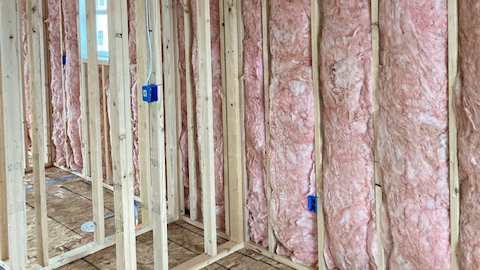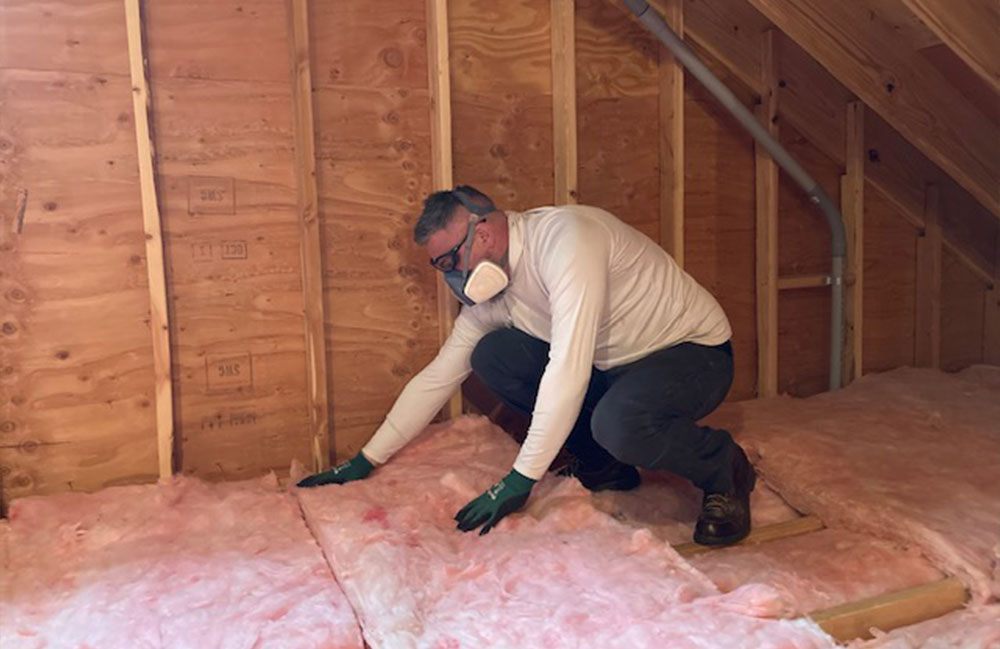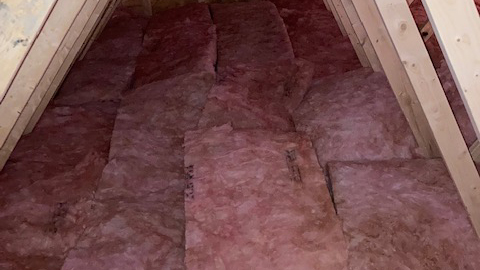Fiberglass Insulation
Cost-Effective and Reliable Insulation for Improved Energy Efficiency
Full Line of Residential Fiberglass Insulation Services in Connecticut
Looking for an easy-to-install, allergen-friendly, eco-friendly and affordable insulation for your home? Look no further. Fiberglass insulation is the best choice. You can use it to insulate walls, attics, roofs, ceilings, basements, and your entire home, really.
Green Apple Spray Foam can efficiently insulate spaces of all shapes and sizes. An inexperienced contractor might not adequately insulate around plumbing or corners which results in drafts and chilly room temperature. Our experts will install blown fiberglass insulation in a deep, homogeneous layer for maximum energy efficiency. We also install fiberglass batts, filling all the cavities without any gaps and holes. We ensure that you achieve optimum performance, improved comfort and lower energy bills.


What Does Fiberglass Insulation Consist Of?
Fiberglass is one of the most commonly used home insulation materials and is created by mixing heated glass and sand particles to generate a fibrous thermal barrier. About 40% to 60% of the content in fiberglass comes from recycled glass, making it a good choice for eco-friendly insulation. It is a cost-effective method for insulating houses and is available in rolled batt or loose-fill forms to suit the needs of diverse applications.
Fiberglass Insulation for Retrofit and New Construction Projects
Our skilled team uses fiberglass insulation for both retrofit (re-insulation) and new construction projects. We have completed various residential projects and can install fiberglass insulation material anywhere it is required.
Why Choose Us for Cellulose Insulation?
High-Quality Insulation Products
We use only the best products by Owens Corning and Certainteed to ensure matchless quality in insulation. These products provide superior performance, excellent coverage, and a high R-value per inch. Some of the fiberglass products we frequently use are PROPINK L77, ECOTOUCH SONOBATTS, Sustainable Insulation®, and Optima.
Certifications
Our installers are certified with BPI, NAIMA, and ICAA. This indicates our long-term commitment to excellence, credibility, and expertise.
Efficiency is Our Middle Name
We offer the highest standards of professionalism and customer service. Our team is punctual and courteous and strives to provide you with nothing but the best.
We are local
We are licensed with the state of Connecticut and offer services in and around Brandford, Guilford, Madison, Old Saybrook, Westbrook, Killingworth, and Essex areas. Our dedication and commitment have earned us a great reputation in the towns we serve.
Experience in Fiberglass insulation
Our installers are knowledgeable and skilled and have years of experience. We have developed specialized processes that enable us to install various types of insulation.
Expertise
Our experts can install fiberglass insulation even in the most tricky corners, around the plumbing. We ensure that air leakage is properly sealed through a thick and even layer of insulation.
Why Choose Us for Fiberglass Insulation?
We Put Customer Service at the Heart of Everything We Do
High-Quality Insulation Products
We are local
We are licensed with the state of Connecticut and offer services in and around Brandford, Guilford, Madison, Old Saybrook, Westbrook, Killingworth, and Essex areas. Our dedication and commitment have earned us a great reputation in the towns we serve.
Certifications
Our installers are certified with BPI, NAIMA, and ICAA. This indicates our long-term commitment to excellence, credibility, and expertise.
Experience in Fiberglass insulation
Our installers are knowledgeable and skilled and have years of experience. We have developed specialized processes that enable us to install various types of insulation.
Efficiency is Our Middle Name
We offer the highest standards of professionalism and customer service. Our team is punctual and courteous and strives to provide you with nothing but the best.
Expertise
Our experts can install fiberglass insulation even in the most tricky corners, around the plumbing. We ensure that air leakage is properly sealed through a thick and even layer of insulation.
Pros of Fiberglass Insulation
Fiberglass is used in batts, blankets, loose-fill, and foam insulation to keep hot or cooled air in and increase housing energy efficiency. Some of its benefits are:
It lowers your utility bills.
Improves your home’s energy efficiency.
Maintains year-round comfort in your house.
Makes a contribution to a healthy environment
Reduces the transmission of noise.
Enhances the efficiency of your HVAC systems.
Paper Backed Fiberglass Insulation has a built-in vapor barrier to prevent the growth of mold and mildew.
Cons of Fiberglass Insulation
It fails to cover all the nooks, crevices, and anomalies.
It doesn’t stop air leaks fully.
Fiberglass insulation is especially susceptible to moisture.
Needs a lot of space, 16 inches of insulation could get R49 to be at Code.
Wet fiberglass insulation, loses all R-value and has essentially no insulating characteristics until it dries.
Mold formation is common when moisture is present in fiberglass insulation (think roof leaks).
2 Main Types of Fiberglass Insulation
Fiberglass Batts
Batts are panels of fiberglass insulation. Depending on your space, you can choose the right width and size of the fiberglass panels. You can also choose fiberglass batt with or without facings for use in floors, ceilings, and walls.
Blown-in Fiberglass
The second type of fiberglass is loose fill insulation and is referred to as blown-in fiberglass. To blow the fibers into wall cavities or attic, specialized equipment is required, therefore hire a specialist. Blown-in fiberglass is a fantastic choice for many portions of a house or structure, and it can also be utilized for re-insulation projects.
Is It Necessary to Reinstall Fiberglass?
While fiberglass insulation has a life expectancy of 80 to 100 years, it may lose effectiveness with time. After 15 to 20 years, fiberglass batts may lose their structural integrity and part of their insulating characteristics. Fiberglass is air permeable, which can result in “wind washing.” Dust can be blown through fiberglass insulation, lowering the R-value and reducing the efficiency of the insulation.

Where Should You Install Fiberglass Insulation?
Garage ceilings
Interior walls for sound control
Between floors for sound control
Upslope areas in attics
Process of Fiberglass Insulation
Fiberglass can be used in the attic, crawl space, rim joists, and open walls.
It is most usually obtained in blanket form, known as batts, although it is also available in pre-cut lengths and widths.
Typically, fiberglass batts are stapled into place. The majority of batts are made with a paper or foil backing that faces the direction of heat.
Loose-fill fiberglass bags can be blown into attics, walls, and floor cavities.
When properly installed, fiberglass can form a barrier that slows the passage of moisture and minimizes the possibility of fibrous particles entering the property.

Differences Between Fiberglass Batt and Mineral Wool
Mineral wool and fiberglass are often confused to be similar but they are different in many ways. Fiberglass insulation is created by weaving fine glass fibers, compressing them, and then cutting them into long rolls or batts. It is available with or without a facing.
Like fiberglass, mineral wool comes in easy-to-install batts. However, it is made up of volcanic rock, typically basalt. Mineral wool is made up of 70% of recycled material and it is highly sustainable.
Mineral wool is highly dense and hard to compress, as compared to fiberglass which can be compressed after a few years of installation and loses its R-value. Typically available without a facing, it is more resistant to moisture as compared to fiberglass.
Like fiberglass, some products of mineral wool have excellent noise reduction and sound absorption qualities. However, mineral wool is a bit heavier than fiberglass. In a few places like attics, where insulation is installed directly on gypsum board, mineral wool might not be preferred as it is heavier, making fiberglass a better choice.
FAQs
Fiberglass batt insulation can be cut with a sharp utility knife. A spare piece of wood can be used as a guide to ensure a clean, crisp cut every time.
Yes, fiberglass insulation is typically regarded as very safe when handled properly. Unless disturbed, the fibers do not become airborne. Fiberglass insulation has been in use for a long time and is found in many homes and commercial buildings.
When installed properly, fiberglass is generally regarded as safe. Fiberglass sits safely between panels, sheetrock, and plaster once placed; it’s only when it’s removed that fibers go airborne.
The best attic insulation, according to many people, is Spray foam. It enables us to insulate all the nooks and corners which are difficult to reach otherwise. It can be used with blown in cellulose to achieve required R values or used separately.
Another great choice for attic insulation is Fiberglass. It’s made of plastic that’s been strengthened with microscopic glass fibers. The batt variant is available in blanket form, which consists of small, pre-cut parts that may be laid down wherever you need them.
Fiberglass insulation is primarily made up of glass fibers and is unlikely to catch fire.
Yes, foam board insulation works well in conjunction with batt insulation. When utilized in batt-insulated wall and ceiling assemblies, foam board insulation can provide insulation and prevent thermal bridging. It may also be used in place of the vapor barrier and house wrap.
It is 5 1/2 inches thick.
Bating is a term used to describe pre-cut pieces such as 4’ or 8’ that make standard insulation easier on installers.
How It
Works
Reliable, local insulation services. We aren’t just an insulation company. We insulate dreams.
01
Schedule Inspection
02
Get Estimate
03
Save Energy
Contact Information
Visit Us
237 Stepstone Hill Road Guilford, CT 06437

